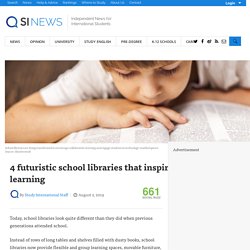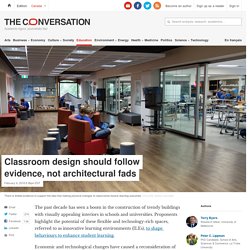Designing Spaces for Learning
> Karenmalbon
Charles Sturt University M.Ed subject INF536
These cool school libraries encourage students to read. Today, school libraries look quite different than they did when previous generations attended school.

Instead of rows of long tables and shelves filled with dusty books, school libraries now provide flexible and group learning spaces, movable furniture, iPads and computers, learning pods, and more. Architects are being hired in certain schools to completely re-design and transform libraries to attract students to not only read, but use the space to their own advantage. By making these facilities visually appealing, as well as comfortable and playful with elements such as reading nooks and beanbags, kids are more engaged and inspired to enjoy reading and learning. Here are some examples of school libraries of the future that align with 21st century teaching methods (such as collaborative learning) and incorporate technology and visual elements to encourage independent learning and make reading fun. The Learning Hub, St Andrew’s Anglican College. School library designing – For school library teams and school communities. (Re)Designing the library through school community participation.
Designing a school library presents exciting and sometimes daunting challenges.

It can bring the whole school community together in a shared creative purpose. However, as one experienced teacher librarian commented: ‘It’s not enough to have a pretty building or space, it has to work as well’ (Bland, Hughes & Willis, 2013).
Suppliers
St Andrew's Cathedral School Library. The Library as Third Space. I’m always thinking about how the school library should function as part of a whole school.

Often, public libraries are called “third spaces,” i.e., “where you go and spend time in addition to your home and workplace. … ‘Third places’ are ‘anchors’ of community life and facilities and foster broader, more creative interaction” (Library as the Third Place). School libraries are a little different, sometimes. Classes are often brought to the library as an extension of the classroom.
The School Library as The Third Place. Looking at the school library as a third place for students, parents, and faculty For over eight years we have developed a Learning Commons environment for our library.

One of the big things that we investigated in the planning stages, was the idea of the library as “the third place.” This term was coined by professor emeritus of sociology at the University of West Florida Ray Oldenburg.
Designing a Public School From Scratch On a mission to reimagine traditional schooling, a K–8 school in San Diego puts teachers and students at the center.
The offer sounded too good to pass up—a paid year off from teaching to create a new public school with a mission to “change the way we do school.”

To 26-year teaching veteran Tom Downs and the others who applied, the sabbatical promised the opportunity to build the school they had always dreamed of, working alongside educators who shared a commitment to innovation. “I don’t know if I would have lasted much longer as a teacher if I stayed doing the same thing I was doing,” Downs reflected. “I need to feel like I’m doing something new, that I’m pushing to make some kind of difference.” Five teachers, including Downs, were accepted to be part of the task force to create Poway Unified School District’s 39th school, Design 39 Campus, from the ground up—using insights from schools around the nation, guidance from industry leaders, and input from a myriad of local residents.
Opening the school in 2014 was no easy endeavor.
Biblo Tøyen: Norway’s unique library for kids ages 10 to 15. Forget what you think about libraries!

Biblo Tøyen, one of Oslo Public Library’s (Deichmanske bibliotek) newest additions, is breaking and changing all the library rules! This is a unique and innovative space, created for young people ages 10 to 15.
Classroom design should follow evidence, not architectural fads. The past decade has seen a boom in the construction of trendy buildings with visually appealing interiors in schools and universities.

Proponents highlight the potential of these flexible and technology-rich spaces, referred to as innovative learning environments (ILEs), to shape behaviours to enhance student learning. Economic and technological changes have caused a reconsideration of the nature of teaching and learning. This narrative has been used to underpin the call to re-imagine school learning environments. Critiques highlight the constrained, static design of conventional classrooms, which favours more traditional teaching practices. It is suggested this is not conducive to those learning experiences favoured in current policy.
Library by Design, Spring 2015. COLLABORATE & LISTEN Staff, like patrons, need flexible spaces in whichto work together, as illustrated by North Carolina State University’s Hunt Library.Photo by Brent Brafford/NCSU As libraries make their public-facing spaces more people-focused and mobile tech makes big us/them service desks obsolete, it’s important to ensure that staff have creativity-enhancing spaces of their own along with the work processes, tools, and training to be effective.

Libraries everywhere are making great strides on behalf of their users.
Changing Spaces, Changing Minds – Libraries and Learning Spaces as Places of the Future. Today my colleague and I were fortunate to participate in a workshop run by the passionate and inspiring Liz McGettigan, who is the Director of Digital Experiences at SOLUS.

The workshop was entitled Changing Spaces, Changing Minds, and focused on how to combine the physical with the virtual in public spaces. Although the workshop was aimed at Librarians, and investigated Liz’ and the participants’ experiences in libraries, many of the ideas and concepts could easily be adapted to apply to any learning space. Like many institutions, libraries are currently in a state of flux.
Whereas once libraries were a fount of knowledge, and librarians the gatekeepers of information, today, everyone has the world’s information in their pocket.
Design Thinking for Educators. Design Thinking. Welcome to the Design Thinking branch of the rethinked*annex database.

This is the virtual space where I (Elsa) collect all things Design Thinking: videos, books, graphics, interviews, etc. How to recognize Design Thinkers ~ Since Roger Martin and others hijacked the term ‘designthinking’, there is an ongoing dispute. Two thought worlds exist and possibly these can be united by laying bare the essential characteristics of a ‘design thinker’. via Team Cognition, published October 30, 2012. Rethinking Design Thinking, Part I ~ The term design thinking has gained attention over the past decade in a wide range of contexts beyond the traditional preoccupations of designers. The main idea is that the ways professional designers problem-solve is of value to firms trying to innovate and to societies trying to make change happen.
The Business of the Design of Business ~ Business has officially taken notice of design. Design Thinking: Making Better Stuff or Making a Better World? IDEO Method Cards. 4 Tips to Transform Your Learning Space. Editor's Note: Elissa Malespina, Jennifer LaGarde, and Laura Flemming contributed to this post. I have always been infatuated with libraries.
Before you renovate: check out Anne Weaver’s Potter Library renovation journey. Among the inspiring sessions I attended at EduTECH, was Anne Weaver’s session on Designing the Contemporary Library.
I had the opportunity to visit the Potter Library, attend a staff meeting, and watch the action on Destination Day. (Students and staff dressed in outfits representing where they’d most like to be, and so Anne greeted me in bunny pajamas.) I was blown away by the thoughtful, student-centered design in the beautiful, flexible, colorful new space.
The design considers the site’s urban environment and elements throughout connect with the school’s “Circle of Mercy” symbol.
Tips for Creating Wow-Worthy Learning Spaces. "Look at your learning space with 21st-century eyes: Does it work for what we know about learning today, or just for what we knew about learning in the past?” -The Third Teacher Does your classroom mirror the rectilinear seating arrangement popular in Sumerian classrooms, circa 2000 BCE? Or is your classroom seating flexible and tricked out with the IDEO designed Node Chair by Steelcase? What classroom design changes can you do on a budget that supports learning? Those questions and more are answered below.
How a Moveable Space Can Ignite Creativity in the Classroom.
Designing Library Spaces – From Dreams to Reality. By Kay Oddone We are fortunate here in Brisbane Catholic Education in that almost every school has a library. This space, whether it is a state of the art, architect designed, contemporary I-Centre or a converted classroom made warm and welcoming with paint, cushions and a few comfy chairs provides not just an area to house books and resources, but a space where just about anything is possible!
Design Thinking in the Classroom – EDUWELLS. Design thinking is a powerful tool to really get your students thinking about and tackling a problem or topic at a much deeper level. It is a structured task that focuses on giving considerable time to thinking about and empathising with the people within the situation (Target audience or client), designing and prototyping a possible solution that is immediately challenged in order to improve it. It is used much in business and the design industry but can be used as a general classroom task within any subject area. It also gets students to work quickly without much introduction. Design thinking promotes creative thinking, team work, and student responsibility for learning.
"Design Thinking" cartoon. School Library or Learning Common. Libraries are no longer being used only as places to store and distribute books, nor do they serve as places only for studying.
With changes in technology, libraries have been forced to change their ways of operating. 21st century school libraries must adapt by becoming People-Centric, instead of being Book-Centric. They need to become community resources for thinking, collaborating, creating, and sharing. Leave your mark by re-designing the school library! Understanding is the first phase of the design thinking process.
During this phase, sixth grade students will immerse themselves in learning. The challenge is to redesign the Goshen Center School Library to become a 21st century space. QUESTION 1: What does a school library look like when it is designed around this idea of “People-Centric” instead of “Book-Centric”? Resources: View the videos to gather evidence to support your opinion. Record your findings on:
Innovation Spaces in School Libraries: A Sustainable Model?
The fact is that given the challenges we face, education doesn't need to be reformed – it needs to be transformed. The key to this transformation is not to standardise education, but to personalise it, to build achievement on discovering the individual talents of each child, to put students in an environment where they want to learn and where they can naturally discover their true passions. (Ken Robinson, The Element: How Finding Your Passion Changes Everything) The Innovation Centre seems to be the next generation of re-inventions for school libraries.
Students engage in design thinking in physical and virtual spaces that become collaborative laboratories for students to share knowledge. Some versions of innovation centres provide workshops, presentations, and lectures to support creativity and production. . . . what would these innovative spaces look like in a high school library? Amy viewed developing the Innovation Centre as a process: The Touch Table Touch Table. Design thinking resources – Zaana Howard. Higher Ed Pays Attention to Design Thinking. What does a school library look like in the digital age?
New school buildings - some practical considerations - Teacher. Educator Duo Reflects on How Design Thinking Has Transformed Their Teaching — The Teachers Guild.
Edutopia. Divine Design: How to create the 21st-century school library of your dreams. Modern Spaces for Contemporary Learning. Theconversation. LEaRN. CAUL Learning and Teaching Advisory Committee. OER Commons. Linking learning spaces to pedagogy - Teacher. Pursuit by The University of Melbourne.










